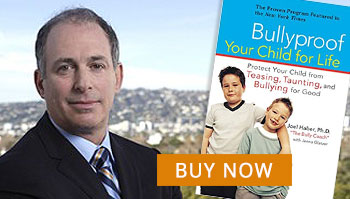
Aside from the fact that they may look different and speak different from other kids, there are certain factors that are common among kids with special needs, and can cause them to be easier bullying targets.
• Not good at understanding sarcasm and teasing. Often, a vicious kid will pretend to be a child’s friend, when he’s actually making fun of him for the amusement of friends. His tone and his words may not match, and your special-needs child might not understand what’s going on—at least until the bully does something truly mean. It’s important for parents and teachers to define bullying for children who may not recognize it, and give plenty of examples of what bullying “looks” like and “sounds” like.
• Outdated fashion. Many kids with special needs don’t follow fashion and hair trends like other kids—thus, they rely on their parents’ sense of style, which doesn’t often fly with their peers. This is a correctable problem. Try to pay attention to current styles if you don’t want your child to have an additional social handicap.
• Aggressive or inappropriate responses. Kids with special needs are often bad at tempering their responses when they’re upset. They may react with extreme anger, tears, pulling on their hair, throwing a fit, etc.—all of which bullies love. • Easy to persuade. Kids with special needs are often eager to please and want to fit in, so they’ll do what other kids tell them to do, even if it’s degrading or will get them in trouble.
• Hygiene problems. Kids with special needs are often not as conscious of cleanliness as other kids, and may have messy eating habits, forget to wear deodorant, and so on. Don’t let this be the reason other kids pick on her: Even if you don’t see the big deal if she wants to skip a shower or eat with her hands, other kids do. It’s important that you enforce strict hygiene rules and manners—for your child’s sake.
• Inappropriate affection. One mother was heartbroken that she had to be called in to the principal’s office to discuss the fact that her son was hugging and kissing people. Surely, it was the other kids who should be taught that affection is good, she thought—but the other kids were using it as a reason to make cracks about his sexuality, call him a “retard,” and generally shun him. It was also making teachers and bus drivers uncomfortable. His parents had to set out strong guidelines about where and when affection was appropriate.
• Few friends. Often, kids with special needs don’t have many friends—and that’s an important predictor that they’ll be easy targets for bullies. They lack the buffers they need. If they do have friends, these friends are probably on the bottom of the social totem pole with them, and may not know how to react to help them in case of a bullying incident.
Character Education
These days, many teachers try to mix character education in with the more traditional academics. Most teachers do have lessons about diversity and acceptance of others. It’s important to start teaching kids at a very early age that differences are okay, and that “different” doesn’t mean “bad.” Here, the teaching of empathy and acceptance of differences goes hand in hand to prevent bullying. If the teacher is not particularly adept at addressing these subjects, there are many resources designed to help. All students need to be taught what disabilities are, and how to treat people with special needs. Some of the tools a teacher may use: • Kids on the Block. This educational puppet troupe has skits about various disabilities after a school assembly in which the video was played by a psychologist, classmates apologized to her son for the way they’d treated him, began sitting with him at lunch and included him in sports—in spite of his lack of physical skills.”
Bullying Within Special Education Classes
It’s not always a matter of nondisabled students picking on kids with disabilities. The real bullying may occur between kids with special needs. Many times, there are teachers or other adults around to protect kids with special needs when they interact with other students. However, the socialization that goes on within the special needs group is where the learning needs to occur. When kids with special needs can learn social tools to recognize when someone is getting angry or upset when they themselves are pushing buttons, it sets up a safer environment for these behaviors to be tested in the broader population. Adults need to role-play and practice these skills with the kids and give them opportunities to practice them within their group before venturing out. The more kids with disabilities can test out these skills with adults or peer models nearby, in actual situations to coach them, the better chance there is for them to learn.
The Laws of Disability Harassment
The Office for Civil Rights (OCR) and the Office of Special Education and Rehabilitative Services (OSERS) within the United States Department of Education sent out a letter to school principals, superintendents, and college and university presidents in 2000 reminding them that disability harassment was a very important issue, and that the problem seemed to be growing: they were fielding phone calls and witnessing court cases on this topic at an alarming rate. Therefore, they wrote a letter that included the following:
Schools, colleges, universities, and other educational institutions have a responsibility to ensure equal educational opportunities for all students, including students with disabilities. This responsibility is based on Section 504 of the Rehabilitation Act of 1973 (Section 504) and Title II of the Americans with Disabilities Act of 1990 (Title II), which are enforced by OCR. Section 504 covers all schools, school districts, and colleges and universities receiving federal funds. Title II covers all state and local entities, including school districts and public institutions of higher education, whether or not they receive federal funds. Disability harassment is a form of discrimination prohibited by Section 504 and Title II. Both Section 504 and Title II provide parents and students with grievance procedures and due process remedies at the local level. Individuals and organizations also may file complaints with OCR.
The letter sought to remind educators that states and schools were responsible to ensure a free appropriate public education to eligible students with disabilities, and that parents could file complaints with the Office of Civil Rights or their state educational agency if they felt their children’s education was being denied because of disability harassment. They concluded:
Schools, school districts, colleges, and universities have a legal responsibility to prevent and respond to disability harassment. As a fundamental step, educational institutions must develop and disseminate an official policy statement prohibiting discrimination based on disability and must establish grievance procedures that can be used to address disability harassment. A clear policy serves a preventive purpose by notifying students and staff that disability harassment is unacceptable, violates federal law, and will result in disciplinary action. The responsibility to respond to disability harassment, when it does occur, includes taking prompt and effective action to end the harassment and prevent it from recurring and, where appropriate, remedying the effects on the student who was harassed.
Their recommendations for schools included a written policy prohibiting discrimination based on disability, discussion of disabilities in the classroom, encouraging reporting of bullying incidents, counseling for both targets and bullies, monitoring programs to follow up after bullying incidents, and appropriate training for staff and students to recognize disability harassment.
